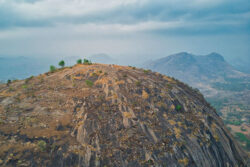I was welcomed by a strong gush of wind. The cold air gave my limbs some much-needed energy; with one last dash, I made it to the top. As I stood to catch my breath, a few swallows in flight looked like they were dancing mid-air just for me. Such was the joy of climbing up to the fort at Medigeshi.

Bird’s-eye view of Medigeshi town
Medigeshi is a small village, so named by a local chieftain of yore, Naggareddi, because his wife’s hair touched her ankles (Medi – ankle, Kesha – hair). The fort is atop a small hillock, and has seen many battles during its heyday. Most of the fort walls remain even today, though in ruins. There are other old structures too, suggestive of people residing within the fort.

View from atop the hill
I gingerly made my way to one of the structures which looked like an old mosque. As I walked along the edges, I noticed I had company – some Common Nawab butterflies were trying to show the Black Rajah that it was their territory. It looked like the Danaid Eggfly, which was sitting in a corner, was enjoying all the action. The wall was also home to millipedes, scurrying away in all directions. I diverted my attention towards the surroundings, and all around were green fields and plains dotted with small hillocks. After spending some time enjoying the view from this structure, I continued my explorations.

Anomalous Nawab butterfly

Minarets of the mosque, on top of the hill
The fort walls along the hill’s periphery were covered with lichens. These lichens formed interesting patterns, and in some places, shared space with algae. A male Peninsular Rock Agama made brief appearances every once in a while, making his presence felt. At one spot, I found a female Peninsular Rock Agama building her nest, and I watched her for a while before moving on.

Lichens lining the fort walls

Female Rock Agama building its nest
At one end of the fort, old granaries still remain intact. All around it, Opuntia ficus-indica cacti grew in huge numbers. I noticed that some had fruits on them, which I tasted, colouring my fingers purple in the bargain. Refreshed by the fruit, I continued walking, looking for anything that would give more insight into the life of people who lived here centuries ago.As the sun rose higher in the sky and so did the temperature, the decision to descend was quickly taken. All along the way, grasshoppers of various shapes and sizes could be spotted. If that wasn’t entertaining enough, I had butterflies enthralling me with their beauty. After photographing them for a while, I decided to pack up my camera and just watch them; the pretty sights are now embedded in my memory.

One of the grasshoppers on the hill
While the prey plays in the open, how can the predator be far behind? As if on cue, I saw a bee-eater fly past, returning to its perch. As luck would have it, the bird settled less than twenty meters away. Undaunted by my presence, it preened itself, sometimes pausing to take flight and catch a prey. After sometime, as though indicating that my time was up, the bee-eater flew away to a different perch.

The Green Bee-eater, found in ample numbers around this area
The day had offered me more than I had expected, with the promise that more is in store for me, should I visit again.Getting there: Medigeshi is about 120 kms from Bangalore, on the Pavagada road. The closest town is Madhugiri, which has a couple of small hotels to eat in.





Instagram
junglelodgesjlr